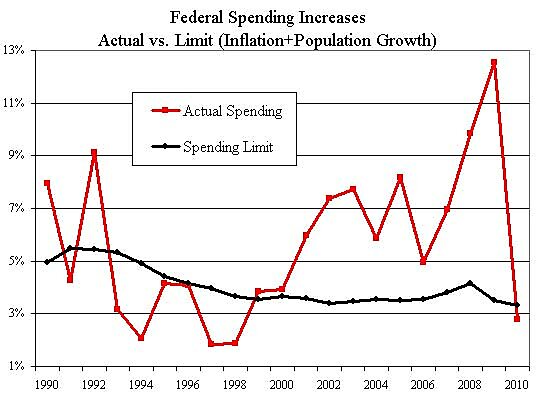The nation is facing a fiscal emergency. Debt is exploding and federal spending exceeds revenues by more than $1 trillion a year. To fix the problem, policymakers should pursue reforms on two paths.
First, policymakers should start identifying programs for termination, privatization, and devolution to the states. If a business conglomerate overexpanded and its spending ran ahead of revenues, prudent managers would start shedding low-value operations and refocusing on core activities. The federal government should do the same.
Second, policymakers should adopt new rules to bring greater discipline to federal budgeting. Right now, it’s anarchy on Capitol Hill with every member and interest group pushing for more dollars. Very few members consistently defend restraint.
The solution is for Congress to pass a law limiting annual increases in overall federal spending. Rep. Lamar Smith (R‑TX) recently introduced legislation to do just that. His SAFE Act (H.R. 5323) would cap annual growth in the federal budget to inflation plus population growth.
Smith’s bill, which has 34 co-sponsors, would cap growth in all spending including defense, nondefense, and entitlements. If spending this year was $3.70 trillion, inflation was 2 percent, and population growth was 1 percent, then federal spending next year would be limited to $3.81 trillion. If Congress failed to get spending under the limit by the end of the year, the president’s budget office would be required to apply an across-the-board cut, or sequester. I’ve discussed some of the details of such a spending limit in this congressional testimony.
Rep. Smith’s spending restraint legislation is exactly the type of budget process reform that Republicans should be championing. The idea of a cap on overall spending was supported by tea partiers in their Contract from America, and it’s easy for the average citizen to understand. The idea is simply that the government’s budget shouldn’t grow faster than the average family’s budget.
With a budget cap in place, it would be easy for voters and activists to know whether Congress was living up to a basic standard of fiscal prudence. If members of Congress tried to cheat on the legal spending limit, or tried to repeal it, citizens could impose political pressure on the spendthrifts. A simple and rigid budget limit would be a high-profile symbol of restraint for people to rally around and defend.
The chart below shows actual spending since 1990 and a budget limit of population growth plus inflation, with those variables averaged over the prior five years. In the 1990s, Congress generally kept spending under the limit. Over ten years, actual spending rose an average 4.2 percent annually, which was less than the 4.6 percent average growth of the limit. By contrast, spending growth during the 2000s has far exceeded the limit, illustrating where today’s huge deficits came from.
In sum, the nation can move back toward fiscal sanity by voting out the big spenders of both parties and voting in a reform-minded Congress to terminate programs and shrink the budget. Then, if Congress passed a law capping overall spending it would lock-in those cuts and make them harder to reverse later on. This two-part process could help ratchet-down the size of government over time.
Notes: Rep. Smith does not specify a five-year average for his spending limit variables, as I’ve assumed here. Also note that federal spending is calendar year data from the National Income and Product Accounts, Table 3.2.

